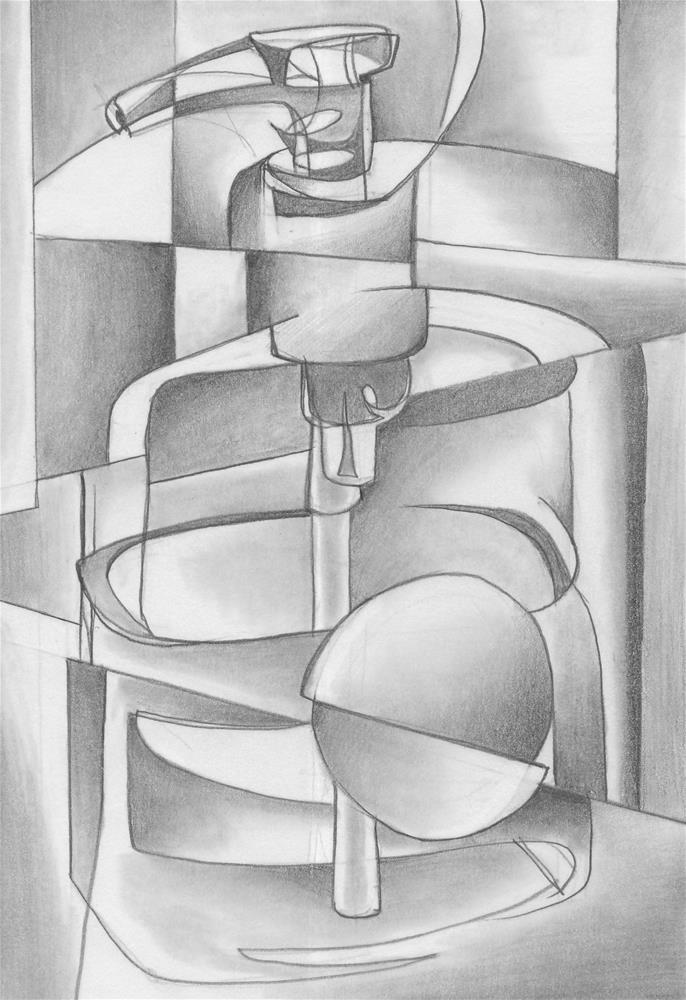(mouse-over to magnify / click to expand)
Jan 28, 2015
Media: graphite on paper
Size: 7.5x5.25 in
Visit the Artist's:
Gallery
Picasso and Braque only explored analytic cubism for a year or two, leaving this style to be explored in more depth by future artists. Here's one of my explorations. From Wikipedia: "In Cubist artwork, objects are analyzed, broken up and reassembled in an
abstracted form--instead of depicting objects from one viewpoint, the
artist depicts the subject from a multitude of viewpoints to represent
the subject in a greater context." To that I would add that Cubism unifies a composition and makes sure that every square inch of the paper or canvas contributes to the overall design. There are no "non-functioning" areas or shapes. In Renaissance portraits for example, often large areas around the head were simply painted black. In Cubism, those shapes wouldn't be left black and "empty." In Cezanne's paintings (Cezanne was considered the father of Cubism), he would often paint the sky with thick visible brushstrokes, so they looked as solid as the mountains. Every area of his paintings is teeming with energy and vibration. Leonard Schlain, in his book, Art and Physics explains this very well: "Cézanne's investigation of space produced several profound revelations that inspired many of the art movements that were to follow. One of the most important of these was the discovery that space was not empty. For centuries space was a negative container within which artists and physicists could arrange objects without affecting the space that surrounded them. The corollary was also held to be true: that space did not affect the movement of objects. In his powerful works, by interlocking broad planes of space with equally broad planes of mass, Cézanne demonstrated that the objects in a painting were integral to the space of the work and were therefore affected." http://www.artandphysics.com/chapter_8_page5.html
Picasso and Braque only explored analytic cubism for a year or two, leaving this style to be explored in more depth by future artists. Here's one of my explorations. From Wikipedia: "In Cubist artwork, objects are analyzed, broken up and reassembled in an
abstracted form--instead of depicting objects from one viewpoint, the
artist depicts the subject from a multitude of viewpoints to represent
the subject in a greater context." To that I would add that Cubism unifies a composition and makes sure that every square inch of the paper or canvas contributes to the overall design. There are no "non-functioning" areas or shapes. In Renaissance portraits for example, often large areas around the head were simply painted black. In Cubism, those shapes wouldn't be left black and "empty." In Cezanne's paintings (Cezanne was considered the father of Cubism), he would often paint the sky with thick visible brushstrokes, so they looked as solid as the mountains. Every area of his paintings is teeming with energy and vibration. Leonard Schlain, in his book, Art and Physics explains this very well: "Cézanne's investigation of space produced several profound revelations that inspired many of the art movements that were to follow. One of the most important of these was the discovery that space was not empty. For centuries space was a negative container within which artists and physicists could arrange objects without affecting the space that surrounded them. The corollary was also held to be true: that space did not affect the movement of objects. In his powerful works, by interlocking broad planes of space with equally broad planes of mass, Cézanne demonstrated that the objects in a painting were integral to the space of the work and were therefore affected." http://www.artandphysics.com/chapter_8_page5.html
|


 Email to a Friend
Email to a Friend









































































































